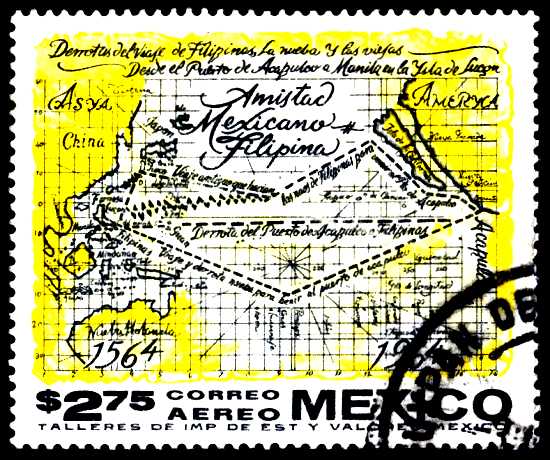In 1559, King Philip II of Spain ordered a fleet to be prepared to sail west from New Spain (Mexico) to the Philippines. Barra de Navidad, on the shores of Jalisco, was one of the centers of New Spain’s maritime activity at the time. It offered a sandy beach in a well-protected bay; with tall forests inland to provide the necessary timber. Barra de Navidad echoed to the sounds of hammering and sawing, as the Spanish fleet was readied.
All western Mexico was mobilized to support the venture. Roads were built to ferry supplies from the city of Guadalajara to the Barra de Navidad boatyards. To this day, the main Guadalajara-Barra de Navidad road is known as The Philippines Way. Food, planks, sails and rigging – all had to be acquired and transported to the port. Every village had to support the effort, which was not without its dangers. For example, the Indians from Ameca complained of “many killed in the transport of rigging to Puerto de la Navidad where they are building boats to go to China.”
The expedition finally set sail at 3:00am on 21 November 1564, marking the start of more than 400 years of friendly contact between Mexico and the Philippines.
The expedition’s commander, López de Legazpi, fearing a mutiny, did not reveal their true destination to his sailors until the boats were well under way; no previous expedition had ever managed to find its way back across the Pacific Ocean. The expedition landed in the Philippines in March 1565. López de Legazpi remained there, putting his 17-year-old grandson in charge of finding the way back. In one of the most amazing feats of sailing of all time, his grandson was successful, but when the expedition reached Acapulco in October the crew was too exhausted to drop anchor. The return voyage had cost more than 350,000 gold pesos, and is commemorated today by a simple monument in Barra de Navidad’s small plaza.
The map on the stamp issued in 1964 to celebrate 400 years of friendship between Mexico and Philippines shows the expedition’s routes across the Pacific. The southern line marks the outward route, the northern line the route home.
The Spanish authorities quickly decided that bringing Asian goods from their colony in the Philippines back to Spain by crossing the Pacific, transshipping the cargo across Mexico and then sailing from Veracruz to Spain was preferable (more secure) to any alternative. Barra de Navidad soon became a regular port-of-call for Spanish sailors plying the so-called China route between Acapulco and Manila. To enable easier communication between Mexico City and Acapulco, a Camino Real (Royal Road) for pack mules was built between Mexico City and Acapulco. (A road suitable for wheeled vehicles between these cities was not completed until well into the 20th century.)
Demonstrating strong complementarity, for 250 years Spanish galleons carried Mexican silver to Manila and returned with spices, silk, porcelain, lacquer ware and other exotic goods from the Orient. These “China galleons” displaced 2000 tons and were the largest seafaring vessels of their time in the world.
But the lure of easy treasure drew pirates such as Englishman Francis Drake. In 1579, Drake sacked the small port of Huatulco, now a premier multi-million dollar tourist resort in the state of Oaxaca, and attacked the Manila galleon off the coast of California, exposing the vulnerability of Spanish sea traffic. For the next forty years, all the west coast ports, including Barra de Navidad, saw more pirates and corsairs than was good for them. Then, slowly but surely, the center of colonial operations moved further north into Sinaloa and Baja California.
Related Post
The development and characteristics of Mexico’s transportation network are analyzed in chapter 17 of Geo-Mexico: the geography and dynamics of modern Mexico. Buy your copy of this invaluable reference guide today!

Sorry, the comment form is closed at this time.